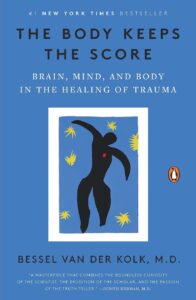The book, The Body Keeps the Score (2014), delves into the devastating impact of trauma on an individual’s life and its far-reaching effects on those around them.
The author, Bessel van der Kolk, MD, is a highly-regarded physician, researcher, and teacher in the field of post-traumatic stress. With extensive experience and expertise in the subject, van der Kolk sheds light on the challenges faced by trauma survivors, and offers hope through various ways of healing. He is a professor of psychiatry at the Boston University School of Medicine and has previously authored books such as “Psychological Trauma” and “Traumatic Stress: The Effects of Overwhelming Experience on Mind, Body, and Society.”
Discover the Benefits: Understanding the Impact of Trauma on Your Body and Mind.
We’ve all heard the tales of trauma-stricken war veterans struggling with their traumatic experiences and finding it difficult to reintegrate into society. The pain and violence they have endured, either as perpetrators or witnesses, can leave them grappling with memories, hypersensitive reactions, and feelings of estrangement from themselves and loved ones.
What exactly happens to our bodies and minds when we experience trauma? And why is it so challenging to overcome?
In these insights, you will learn the reasons why traumatic events linger in our lives, the way trauma affects a person’s perception of their surroundings, and why there is hope for healing.
You will also uncover:
- The reason why war veterans tend to trust only each other
- How a seemingly innocuous image in a magazine can trigger traumatic memories
- The healing power of yoga in reducing the pain of trauma patients.
Idea 1 – The Widespread Prevalence of Trauma in Society.
Contrary to popular belief, trauma isn’t exclusive to war veterans, it is far more common in our society than we realise. Trauma can affect anyone and it is crucial that we understand the true extent of its reach.
Trauma stems from a traumatic event that leaves an individual feeling helpless or overwhelmed and unable to cope with the situation. While war is a common cause of trauma, other triggers include violent crimes, accidents, and even sexual assault and child abuse.
Statistics show the shocking reality of trauma in our society. In 2014, 12 million women were reported to be victims of rape in the United States, with over 50% of them being under the age of 15. And every year, there are 3 million cases of child abuse in the country.
These traumatic experiences have a profound impact on the lives of those affected, as well as their friends and family. Many individuals who have experienced trauma suffer from post-traumatic stress disorder (PTSD), which can lead to depression, substance abuse, and other related issues.
Moreover, individuals with PTSD often find it challenging to trust anyone who hasn’t undergone similar trauma, leading to feelings of mistrust and isolation. The author’s own experience working with Vietnam veterans in therapy groups illustrates this point, where it took several weeks of building trust for the author to be accepted by the group.
Maintaining relationships, such as marriages, close friendships, and parent-child relationships, can be extremely difficult for those who have experienced trauma. They often struggle to trust even their loved ones, leading to strained relationships and, in some cases, estrangement or divorce.
Idea 2 – The power of trauma to linger in the mind and body is on full display through the phenomenon of flashbacks.
These vivid and distressing reminders of a traumatic experience can cause the body and brain to respond as if the event were happening all over again.
The author of the book conducted an experiment to study the effects of flashbacks on patients with PTSD. Participants agreed to listen to a recording of a script that recreated their traumatic experience while inhaling air with a small concentration of radioactive particles. This allowed the author to see which parts of the brain were activated in response to the traumatic memory.
The results were striking. As patients listened to the script, their heart rate and blood pressure spiked, while the left side of their brain, responsible for rational thinking, became deactivated. This made it difficult for them to realise that the experiences they were reliving were not real.
In one participant, a 40-year-old teacher named Marsha, the Broca’s area responsible for speech showed a significant decrease in activity, leaving her unable to speak. Her stress hormone levels also skyrocketed and remained elevated, a clear indication of the impact that being reminded of trauma can have on the body.
Flashbacks are a potent reminder of the lingering effects of trauma, causing the body and brain to respond as if the traumatic experience were happening all over again.
Idea 3 – Childhood trauma can have lasting effects that extend far beyond a person’s youthful years and into adulthood.
Being traumatised as a child is even more difficult as young brains are not fully developed and therefore, children who go through traumatic experiences are more susceptible to a wide range of negative outcomes. These consequences may arise soon after the trauma, as well as in adulthood.
The author conducted an experiment to showcase how traumatic experiences can lead children to expect negative outcomes. They showed cards with pictures from magazines to both traumatised and non-traumatised children.
For example, when presented with a card showing two children watching their father fixing a car while lying underneath it, the non-traumatised children imagined a positive outcome, such as the father successfully fixing the car and taking the children to McDonald’s. However, the traumatised children envisioned much darker scenarios, such as the father being struck on the head with the hammer he was holding or the car falling and crushing him. These children saw triggers in the image that led them to imagine a violent end.
Unfortunately, these thought patterns often persist into adulthood. One of the author’s patients, Marilyn, a former nurse, revealed that she had a happy childhood, but in reality, she was sexually abused as a child, a traumatic experience that affected her entire adult life. She became prone to lashing out when men touched her, even in her sleep, and developed an autoimmune disease that damaged her vision, likely due to the stress her trauma put on her body.
Marilyn’s story is not unique, as many individuals who were traumatised in childhood continue to suffer in adulthood.
Idea 4 – Traumatic memories are a stark contrast to normal memories, as they remain vivid, unchanging, and easily triggered.
Unlike typical memories, which tend to fade and change over time, traumatic memories are deeply ingrained in our minds and evoke intense emotions and sensory experiences.
When asked to recall non-traumatic events, such as a child’s birth or a wedding, people generally remember their overall feelings but struggle to recall specific sensory details like the scent of the room or the appearance of someone’s hair. However, when it comes to traumatic memories, the sensory aspects of the experience are often remembered with great detail. For example, a participant who was raped reported that the smell of alcohol immediately triggered traumatic memories and prevented her from attending parties.
Studies have confirmed that traumatic memories are persistent over time. A study conducted at Harvard Medical School tested 200 men over several decades and found that while the memories of those who didn’t experience trauma changed over time, the traumatic memories of war veterans with PTSD remained consistent and unchanged for over 45 years.
Trauma can have a profound and lasting impact on the brain and body, making it difficult to forget traumatic experiences. The challenge for those who have experienced trauma is how to learn to live with it.
Idea 5 – A technique known as EMDR, or eye movement desensitisation and reprocessing, helps integrate traumatic memories and regain a sense of control over their mind and body.
This technique involves guiding patients through a traumatic memory while they follow a moving finger with their eyes, allowing them to make new associations along the way.
Although the exact workings of EMDR remain a mystery, it has been shown to be highly effective in helping patients process and integrate traumatic experiences. Unprocessed traumatic memories can be relived as if they’re happening in real-time, but once integrated, they can become simply another part of a patient’s past, freeing them from its grip.
The author describes a successful case of EMDR with Kathy, a woman who had been forced into prostitution and suffered multiple forms of sexual abuse. Through EMDR, Kathy was able to process and reframe her traumatic memories, leading to her recovery and eventual happiness. In one session, she visualised crushing her childhood home, the site of many traumatic memories, with a bulldozer. In another, she imagined locking her abusive father out of a cafe and watching everyone around her laugh. After eight sessions of this kind of progress, Kathy made a remarkable recovery and was later considering adopting a third child.
Idea 6 – Yoga provides a safe means for trauma survivors to examine the connection between their mind and body.
The bond between our body and mind is a strong one, and it’s important to understand the influence our emotions have on our physical state in order to lead a balanced life. However, trauma can make this understanding difficult.
Trauma often results in a heightened sense of alarm in the body, leading to intense anxiety in seemingly harmless situations for those who have experienced it, such as sexual abuse. To cope with these overwhelming emotions, some individuals turn to unhealthy coping mechanisms, such as substance abuse or excessive work, which only further harm their mental health. Yoga, however, provides a healthier alternative for trauma survivors.
Yoga offers a secure way for trauma survivors to tune into their emotions and comprehend the physical manifestation of those emotions. One of the author’s patients, Annie, a victim of rape and PTSD sufferer, took on the challenge of practicing yoga. Despite the initial difficulties of the practice, such as the trigger of her alarm system from even a simple pat on the back, Annie persevered.
With time, Annie became more attuned to the signals her body was sending about her emotional state. One particular pose, the “happy baby,” which involves lying on your back with bent knees and feet in the air, caused her immense pain, vulnerability, and sadness. However, instead of suppressing these emotions, Annie used yoga to confront and accept them. This helped her understand that she had the ability to face negative sensations head-on.
Idea 7 – The Importance of Mindfulness and Social Support in Trauma Recovery
The concept of mindfulness has gained popularity in recent times, but it’s more than just a trend – it’s a highly effective approach to well-being. It’s also a valuable tool in the journey towards trauma recovery.
Trauma often leads to repression of emotions rather than facing them. But by denying these feelings, we miss the chance to address our trauma and begin the healing process. Mindfulness focuses on being present and aware of our emotions and physical sensations, rather than suppressing them.
Trauma can cause a range of negative effects, including depression, stress, and psychosomatic conditions like chronic pain. Mindfulness can help alleviate these impacts and improve immune responses, activate brain regions that regulate emotions, and balance stress hormone levels.
In addition to mindfulness, a strong support system of friends, family, and mental health professionals is critical in the recovery from trauma. Building a network of people who can offer support during difficult times is key. These networks can be found in various ways, such as AA meetings, religious communities, and veteran organisations.
Idea 8 – Rebalancing brain waves through neurofeedback helps trauma survivors heal.
Did you know that the electrical signals in your brain are responsible for every thought and action? These brain waves play a crucial role in our well-being. However, trauma can disrupt them, causing harm to our mental health. But, the good news is that the brain can be retrained.
There are various types of brain waves, one of them being alpha waves, which indicate a state of relaxation and calmness. A recent study at the University of Adelaide showed that soldiers who spent a longer time in war zones had fewer alpha waves compared to those who served for a shorter time. They had similar brain waves to children diagnosed with ADHD, hindering their ability to focus and relax.
This is where neurofeedback comes in. It allows trauma survivors to alter their brain waves and encourage the production of alpha waves, helping them achieve a state of calmness. The patient’s brain waves are displayed in real-time on a screen, and they are given feedback when they need to make a conscious effort to relax. When they succeed, they can see the alpha waves being produced and are rewarded through an interface that resembles a video game.
An example of this is Lisa, a 27-year-old woman who was one of the author’s patients. She had a troubled childhood marked by abandonment by her father and abuse from her mother, and had several traumatic experiences that resulted in self-destructive behaviour. However, after undergoing neurofeedback treatment, she saw a dramatic improvement. With the ability to produce alpha waves and consciously relax, Lisa was able to process and work through her traumatic events.
Although neurofeedback is an effective treatment for trauma survivors, it is not widely used yet. The mental health community still has a long way to go in terms of understanding and treating trauma. Nevertheless, with the growing acceptance of mindfulness practices and increased awareness of mental illnesses, there is hope for a brighter future in mental health treatment.
Concluding thoughts…
The main takeaways from this book are that trauma can have long-lasting effects on a person’s mental and physical well-being, and it is important for individuals who have experienced trauma to have access to effective tools and support systems to help them on their path to recovery. Mindfulness, supportive relationships, EMDR therapy, yoga, and neurofeedback are just some of the methods that can help individuals who have suffered from trauma manage their symptoms and begin the healing process.







